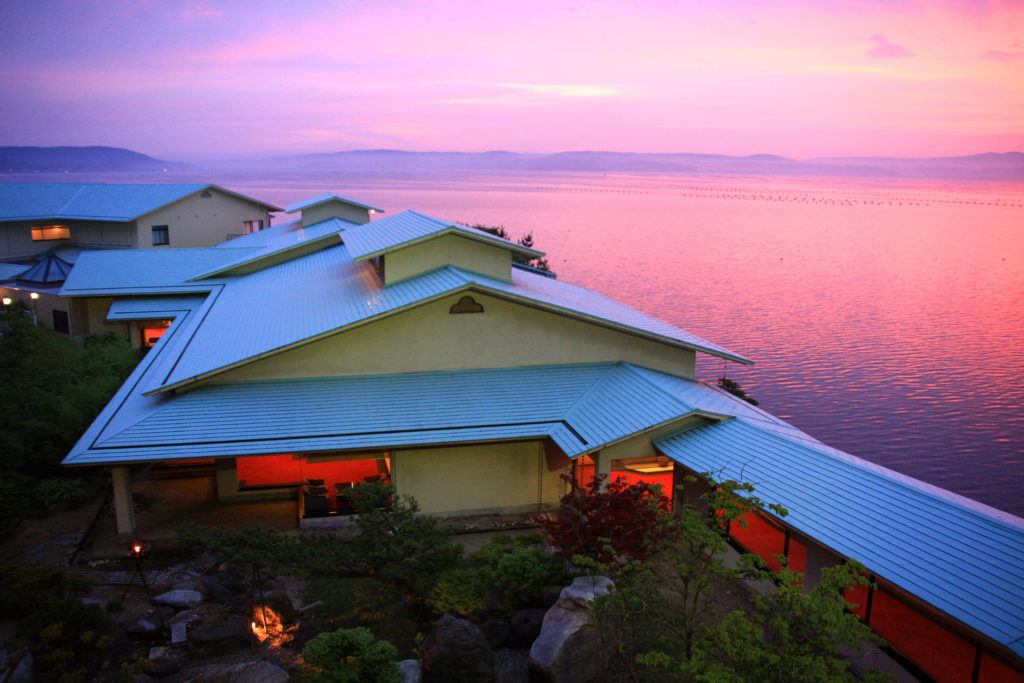Ishikawa’s magical coastal locations are a sustainable celebration of World Oceans Day.
It’s World Oceans Day and to celebrate it all things blue; we are giving a shout out to our northern neighbours, Japan and its renowned seaside escape, Ishikawa.
Its coastal location along the Japanese Sea has shaped the food and culture scene, from eating Nanao Bay oysters to bathing in salt-rich hot springs and centuries-old fishing traditions.
Time to get off the tourist trail and get to know Japan’s rural countryside that bit better with our round-up of the most magical coastal locations in Ishikawa.
Wakura Onsen

Join in on Japan’s most popular relaxation method with visiting the Wakura Onsen. This coastal hot spring village dates back 1200 years, with the movement of the earth’s crust said to have relocated the hot springs 60 metres from the shoreline. A high salt and mineral content remains in the hot spring water today, and the location has attracted visitors for its healing and therapeutic reputation since the Lord of Kaga Domain named it the ‘hot spring of healing’ in 1611.
Enjoy this healing village with a stay in oceanfront onsen accommodation, Tadaya, which serves fresh seafood from neighbouring Nanao Bay, known for its oyster and sea cucumber farming.
Notojima Island
We couldn’t celebrate World Oceans Day without going into the depths of it! One for the avid divers, Notojima Island, is well-positioned with the peninsula safeguarding it from rough currents and winds, making it an ideal diving spot year-round. The sea surrounding Notojima is classified as a World Agricultural Heritage area with this particular spot being popular with underwater photographers due to its high visibility, seaweed forests and wild dolphins.
Chirihama Nagisa Driveway

Chirihama Nagisa Beach Driveway is Japan’s answer to Fraser Island. It is the only drivable beach in the country whereas travellers can drive their car along this 8km stretch of sand, enjoy the sea air and stop to search for shells. Food stalls line the beach from spring to autumn selling local seafood, with Noto Oysters a specialty.
Ama-machi, Wajima City

Wearing only a wetsuit and swimming goggles, Ama (female shell divers) make their living by diving to a depth of over 10 metres, to catch abalone and turban shells, and collect seaweed from the Japanese Sea. There are currently 200 female shell divers in Wajima, 10% of the total number of Japanese female divers, which has decreased from 10000 to 2000 over the past 35 years. Wajima’s Ama range from teenagers to women in their 70s and are the second-largest group in Japan, after Mie Prefecture. The Wajima area is focused on maintaining its number of female divers and preserving the traditional Ama culture that has played a big part in the region for 400 years. Ama divers can be seen at Hegura Island and Nanatsu Island, 50km north of the Wajima coast.
Noto Kongo Coast

If you are one for dramatic scenery, you are in for a picturesque treat. Stretching 14km, the Noto Kongo Coast is known for its rugged form, which rewards visitors with peculiar rock formations, islands and stunning sunsets. The western side of the peninsula is home to The Ganmon Rock and Sea Caves, Hatago Iwa rocks and Japan’s oldest wooden lighthouse. Relive history by visiting the Ganmon (Gate) Rock via a short boat ride between March and mid-November or walk down to the rock and enter a cave that is said to have been a hiding place for Minamoto Yoshitsune when he was fleeing from his brother, Minamoto Yoritomo, the founder of the Kamakura Shogunate. Head north to Hatago Iwa rocks which are considered sacred and are connected by a ‘shimenawa’, a rope used in Shinto to mark the presence of sacred spirits.
Okunoto Salt Farm Village, Suzu City

A celebration of World Oceans Day and Japanese culture at its finest.
Okunoto Shiota Village is the only salt field in Japan that has preserved the traditional sea salt making method of ‘Agehama’ which translates as ‘bringing up to the beach’. The centuries-old process is valued by chefs worldwide for producing natural and mineral-rich sea salt. This sustainable practice includes carrying seawater in buckets from the sea, which is scattered across a large sand bed. Once set, the salty brine is drawn out, and the salt-coated sand is simmered in a large barrel to evaporate the water, leaving crystallised salt. Enrich yourself in the Noto region’s coastal landscape with hands-on experience, making salt from seawater on a deep-sea beach. Reservations are required for this unique salt making experience, with two hour and two-day course available from 1 May – 30 September.
Tsukumo Bay

Marine park Tsukumo Bay translates as ’99 bay’, named after its 99 coves which can be seen on a walk around the bay, sailing or sightseeing boat. The bay has its own campsite with BBQ for travellers to enjoy the gentle lapping sound of the waves on the shore and beautiful views across the calm, blue water into the evening.
Yoshigaura Onsen, Lamp No Yada

This luxury hot spring spa on the northern tip of Noto peninsula offers seclusion amid the crashing of waves against the rocks. The only ryokan in this hot spring location, Lamp No Yada has been operating for 400 years. Rooms have a terrace looking straight out to sea, each equipped with its own onsen bath that you can bathe while listening to the relaxing sounds of the ocean.
Feature image: Ishikawa Travel
See more: Asia travel






